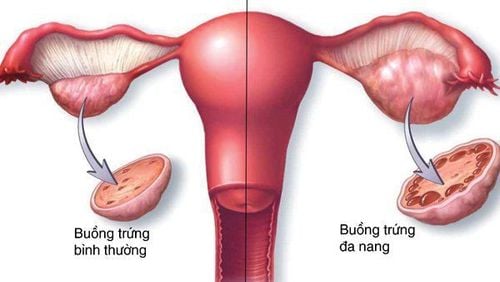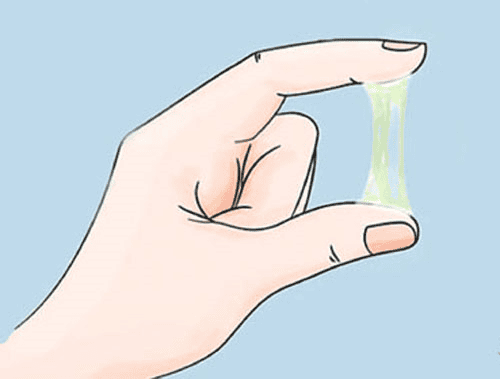If dark brown discharge appears before or after menstruation and is accompanied by other abnormal symptoms, it could signal underlying conditions such as vaginal infections, hormonal imbalances, or gynecological diseases.
1. Is Dark Brown Vaginal Discharge Abnormal?
Dark brown discharge may seem alarming, but it is not always a sign of a medical condition. This type of discharge can occur around the time leading up to menstruation. When blood takes extra time to exit the uterus, it oxidizes, which can give it a brown or dark brown appearance. If you experience dark brown mucus discharge, take note of the timing and any associated symptoms.
2. Causes of Abnormal Dark Brown Discharge
2.1. Hormonal Imbalance
Dark brown discharge may indicate a hormonal imbalance. Estrogen is a hormone that stabilizes the endometrium. If estrogen levels are too low, the endometrium may break down at various points during the cycle. This can result in dark brown discharge or other abnormal bleeding.
2.2. Hormonal Methods of Birth Control
Hormonal contraceptives, such as birth control pills, can cause brown discharge during the first few months of use. If this continues beyond three months, consult your doctor about switching to a different contraceptive method.
2.3. Ovarian Cysts
Ovarian cysts may not cause any symptoms and can disappear on their own within a few months. However, untreated ovarian cysts can sometimes grow larger and lead to symptoms such as dark brown mucus discharge and pelvic pain.

2.4. Sexually Transmitted Infections (STIs)
STIs can lead to brown spotting or abnormal bleeding. Symptoms may include painful urination, pelvic pain, vaginal discharge, and brown discharge between menstrual periods.
Bacterial vaginosis, a non-sexually transmitted infection, results from an overgrowth of harmful bacteria, leading to changes in the texture, color, or smell of vaginal discharge.
2.5. Endometriosis
Endometriosis occurs when the endometrium grows outside the uterus. Symptoms may include abdominal pain during menstruation and abnormal discharge between periods. Other symptoms might include bloating, nausea, fatigue, constipation, diarrhea, painful urination, and pain during sexual activity.
2.6. Polycystic Ovary Syndrome (PCOS)
Polycystic ovary syndrome may cause irregular menstrual cycles, with intervals longer than 35 days and brown spotting between periods. Other symptoms can include headaches, acne, hyperpigmentation, hair thinning, depression, anxiety, mood swings, and weight gain.
2.7. Ectopic Pregnancy
In an ectopic pregnancy, a fertilized egg implants outside the uterus, such as in the fallopian tube, ovary, abdomen, or cervix. In addition to brown discharge, symptoms may include:
- Sharp abdominal, pelvic, neck, or shoulder pain.
- Pain on one side of the pelvis.
- Dizziness.
- Fainting.
- Increased rectal pressure.
2.8. Miscarriage
During a miscarriage, symptoms may occur suddenly, including brown discharge or heavy bleeding. Other symptoms include cramping or lower abdominal pain, passing tissue or clots from the vagina, dizziness, or fainting. While bleeding in early pregnancy can be normal, it’s crucial to report brown discharge or other unusual symptoms to your doctor for diagnosis and guidance.
2.9. Postpartum vaginal discharge
Postpartum vaginal discharge occurs within four to six weeks after childbirth. Initially, bleeding is heavy with small clots. Over a few days, it slows down and becomes pink or brown. After about 10 days, the discharge may turn yellow or cream before disappearing entirely. Consult a doctor if you experience foul-smelling discharge, fever, or large clots, as these may indicate an infection.
2.10. Perimenopause
The transition period several months to years before menopause is called perimenopause, typically starting in the 40s. Estrogen fluctuations during this time can cause irregular bleeding or mucus discharge, often brown, pink, or red. Other symptoms may include hot flashes, insomnia, irritability, mood swings, vaginal dryness, and changes in libido.
2.11. Contraceptive Implant
This form of hormonal contraception is implanted under the skin in the upper arm and releases progestin to prevent pregnancy. Irregular menstrual and brown discharge are common side effects as the body adjusts to the hormones.

3. Dark Brown Discharge Before Menstruation
Brown discharge before your period is usually harmless and can occur for various reasons. Sometimes, it may indicate pregnancy or perimenopause. Less commonly, it might signal an underlying health condition. If you are not pregnant, potential causes of brown discharge include:
- Leftover menstrual blood from the previous menstrual cycle.
- The beginning of a new period with minimal blood flow.
- Ovulation, which may cause pinkish-brown discharge.
- A reaction to a Pap smear test or vaginal examination.
- A response to sexual activity.
- For individuals in their 40s or 50s, brown discharge before menstruation can indicate perimenopause.
- Pelvic inflammatory disease (PID), an infection of the cervix and uterus, may cause brown discharge.
- Sexually transmitted infections (STIs) like gonorrhea or chlamydia.
- A foul-smelling brown discharge charge may occur if a foreign object enters the vagina, such as a tampon, condom, or intrauterine device (IUD).
- Polycystic ovary syndrome (PCOS).
- Brown discharge could be a symptom of cervical cancer, though this is extremely rare.
4. Dark Brown Discharge After Menstruation

Here are possible causes of brown discharge after your period:
- Leftover menstrual blood: Blood that takes longer to leave your body can darken, often appearing brown. It may also seem thicker, drier, or more clotted than fresh blood. This darkening occurs due to oxidation when blood is exposed to air. You might notice darker or brown blood near the end of your period. Some women experience brown discharge for one or two days after their period ends, while others may see it for up to one or two weeks. That really just depends on how your uterus sheds its endometrium and the rate at which blood exits the body.
- Although dark brown discharge after your period is usually not a major issue, it can indicate an abnormality when accompanied by other symptoms: If you experience brown discharge and cramping after your period, it could be caused by polycystic ovary syndrome (PCOS) or early pregnancy. Early miscarriage can also cause these symptoms. Blood from a miscarriage can be red, but it can also be brown and resemble coffee grounds.
- Brown discharge with a foul-smelling after your period: Menstrual blood usually has some smell, but if you notice brown discharge and it has a foul smell, the cause is very likely a sexually transmitted infection (STI).
To arrange an appointment, please call HOTLINE or make your reservation directly HERE. You may also download the MyVinmec app to schedule appointments faster and manage your reservations more conveniently.








